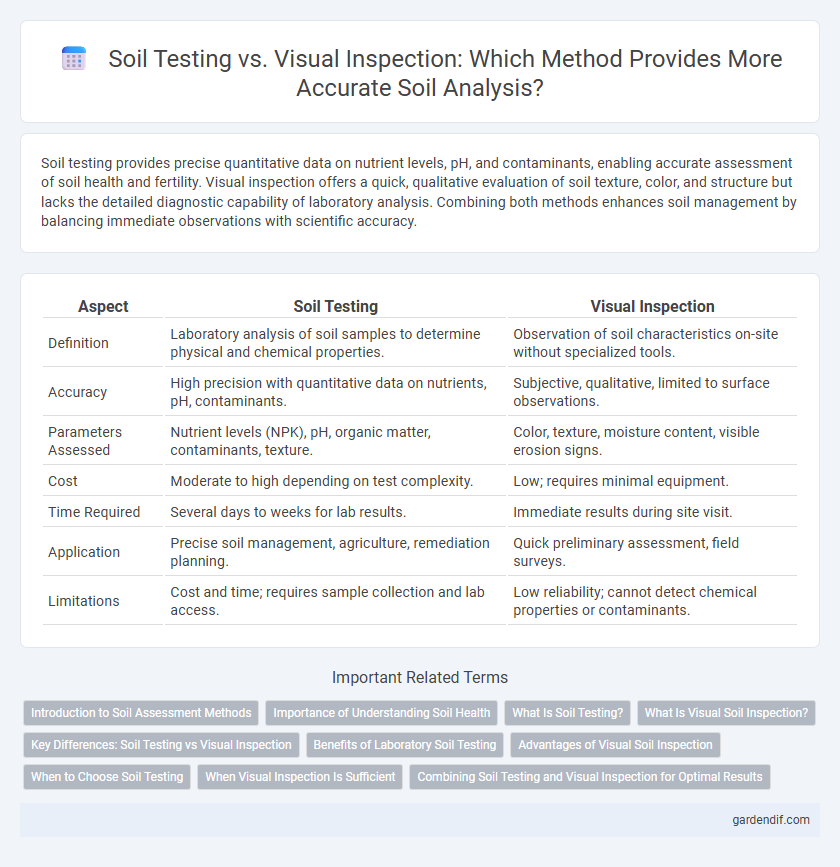
Soil Testing vs Visual Inspection Illustration
Soil testing provides precise quantitative data on nutrient levels, pH, and contaminants, enabling accurate assessment of soil health and fertility. Visual inspection offers a quick, qualitative evaluation of soil texture, color, and structure but lacks the detailed diagnostic capability of laboratory analysis. Combining both methods enhances soil management by balancing immediate observations with scientific accuracy.
Table of Comparison
| Aspect | Soil Testing | Visual Inspection |
|---|---|---|
| Definition | Laboratory analysis of soil samples to determine physical and chemical properties. | Observation of soil characteristics on-site without specialized tools. |
| Accuracy | High precision with quantitative data on nutrients, pH, contaminants. | Subjective, qualitative, limited to surface observations. |
| Parameters Assessed | Nutrient levels (NPK), pH, organic matter, contaminants, texture. | Color, texture, moisture content, visible erosion signs. |
| Cost | Moderate to high depending on test complexity. | Low; requires minimal equipment. |
| Time Required | Several days to weeks for lab results. | Immediate results during site visit. |
| Application | Precise soil management, agriculture, remediation planning. | Quick preliminary assessment, field surveys. |
| Limitations | Cost and time; requires sample collection and lab access. | Low reliability; cannot detect chemical properties or contaminants. |
Introduction to Soil Assessment Methods
Soil testing involves laboratory analysis to determine nutrient content, pH levels, and contaminant presence, providing precise data essential for effective soil management. Visual inspection assesses soil texture, structure, moisture, and biological activity through direct observation, offering immediate but less detailed information. Combining both methods enhances soil assessment accuracy, supporting sustainable agricultural practices and environmental monitoring.
Importance of Understanding Soil Health
Soil testing provides precise data on nutrient levels, pH, and contaminants, enabling accurate assessment of soil health and informing effective management practices. Visual inspection offers immediate, qualitative insights into soil structure, color, and organic matter content, which are crucial for detecting surface conditions and potential issues. Combining both methods enhances understanding of soil health, promoting sustainable land use and optimized crop production.
What Is Soil Testing?
Soil testing involves the scientific analysis of soil samples to measure nutrient content, pH levels, and texture, providing accurate data for optimal crop growth and soil health management. Unlike visual inspection, which relies on surface observation, soil testing offers precise information about micro and macronutrients, organic matter, and contamination levels. This method enables informed decisions regarding fertilization, irrigation, and soil amendments, enhancing agricultural productivity and sustainability.
What Is Visual Soil Inspection?
Visual soil inspection involves examining soil characteristics such as texture, color, structure, and moisture without laboratory analysis. This method helps identify surface features like compaction, erosion, and organic matter content to assess soil health quickly. Unlike soil testing, visual inspection provides immediate, on-site insights but lacks precise chemical or nutrient data.
Key Differences: Soil Testing vs Visual Inspection
Soil testing provides precise quantitative data on nutrient levels, pH balance, and contamination, essential for accurate soil management and crop optimization. Visual inspection relies on observable soil characteristics such as color, texture, and moisture but lacks the detailed chemical analysis necessary for informed agricultural decisions. The key difference lies in soil testing's scientific measurement versus visual inspection's subjective assessment, impacting the effectiveness of soil health evaluation.
Benefits of Laboratory Soil Testing
Laboratory soil testing offers precise analysis of nutrient levels, pH balance, and contaminant presence, enabling tailored soil management plans that enhance crop yield and environmental safety. Unlike visual inspection, lab testing detects hidden deficiencies and toxic elements that are not visible to the naked eye, ensuring accurate diagnosis and treatment. This scientific approach supports sustainable agricultural practices by providing reliable data for informed decision-making and optimized resource use.
Advantages of Visual Soil Inspection
Visual soil inspection offers a rapid, cost-effective method for assessing soil conditions without the need for specialized laboratory equipment. It enables the identification of soil texture, color, moisture, and structure, providing immediate insights into soil health and fertility. This hands-on approach supports real-time decision-making in agricultural management and environmental monitoring.
When to Choose Soil Testing
Soil testing is essential when precise data on nutrient levels, pH, and contamination must guide crop selection or amendment strategies. Visual inspection alone cannot reliably detect micronutrient deficiencies, salinity issues, or toxic substances harmful to plant growth. Opt for soil testing in cases of unexplained poor yield, new land development, or regulatory compliance requirements for soil quality.
When Visual Inspection Is Sufficient
Visual inspection is sufficient for initial soil assessment when identifying obvious surface conditions such as erosion, compaction, or moisture presence. It enables quick evaluation of soil texture, color, and organic matter content without specialized equipment. Soil testing is recommended only when precise nutrient, pH, or contamination levels need to be determined for targeted agricultural or environmental management.
Combining Soil Testing and Visual Inspection for Optimal Results
Combining soil testing and visual inspection enhances accuracy in assessing soil health by integrating quantitative data with observable characteristics such as texture, color, and moisture. Soil testing provides precise measurements of nutrient levels, pH, and contaminants, while visual inspection identifies issues like erosion, compaction, and organic matter presence. This integrated approach optimizes soil management decisions, ensuring sustainable crop production and environmental protection.
Soil Testing vs Visual Inspection Infographic

 gardendif.com
gardendif.com